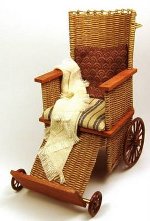The Wheelchair Guide
Your Wheelchair and Mobility Scooter Resource
A Look at Wheelchair Development
Friday, September 11th, 2009 at 9:35 am
Mobility vehicles of some shape or form have been around for hundreds and thousands of years. These devices are important tools for increasing accessibility and allowing those who have difficulty walking to get around.
Early Wheelchair Design
 In the early days, there was no standard to these devices and often they were only affordable by nobility. It was also not uncommon for the kings and other royalty who used these early wheelchairs to need them more as a result of their lavish lifestyle, rather than out of a practical need.
In the early days, there was no standard to these devices and often they were only affordable by nobility. It was also not uncommon for the kings and other royalty who used these early wheelchairs to need them more as a result of their lavish lifestyle, rather than out of a practical need.
This began to change towards the end of the nineteenth century, when a wicker wheelchair was designed. The wicker wheelchair had a very high back and sides, with two wheels on the side and one in the back. Due to its large size and the design of its wheels, it was very hard for a wheelchair user to self propel this type of wheelchair or even to transport it away from the hospital. Still, it was much more effective than previous designs and was adopted across the United States by most hospitals.
The Development of the Folding Self-Propelled Wheelchair
 The wicker wheelchair had a number of design problems that made it very difficult for the average wheelchair user to use. As a result, two inventors, one of whom was in a wheelchair, worked together to develop a lightweight foldable wheelchair. Their design, which is known as the E & J wheelchair, made use of a frame made out of hollow steel tubes, which provided a great deal of support and strength, but without the same weight as that of a wicker wheelchair. The steel tube frame could also be folded up, making the wheelchair much easier to transport.
The wicker wheelchair had a number of design problems that made it very difficult for the average wheelchair user to use. As a result, two inventors, one of whom was in a wheelchair, worked together to develop a lightweight foldable wheelchair. Their design, which is known as the E & J wheelchair, made use of a frame made out of hollow steel tubes, which provided a great deal of support and strength, but without the same weight as that of a wicker wheelchair. The steel tube frame could also be folded up, making the wheelchair much easier to transport.
At the time the E & J wheelchair was invented, America was on the precipice of the Second World War and so the wheelchair was put to great use. The development of antibiotics meant that soldiers were able to recover from wounds that even only a few short years ago would have been fatal, with many soldiers returning from the war without full use of their legs.
The E & J wheelchair would remain the standard for some time and the first electric wheelchairs were built around its frame. A number of companies began to sell converter kits that allowed the E & J wheelchair to be inexpensively converted to an Electric Wheelchair. These made use of a simple electric motor that could be attached to the axle of the wheelchair and controlled by a simple joystick placed on the wheelchair’s arm. While the design of a modern electric wheelchair is much different, the joystick control scheme is the standard for most electric wheelchairs. However, there are also a number of other control systems available for those who can not use a joystick.
Today, the basic design of the E & J wheelchair has remained the same and can be seen in most modern manual wheelchairs, although there are many other popular wheelchair manufacturers.